Coherence代理的负载均衡
Coherence在extend模式下,proxy的负载均衡机制官方解释是
Extend client connections are load balanced across proxy service members. By default, a proxy-based strategy is used that distributes client connections to proxy service members that are being utilized the least. Custom proxy-based strategies can be created or the default strategy can be modified as required. As an alternative, a client-based load balance strategy can be implemented by creating a client-side address provider or by relying on randomized client connections to proxy service members. The random approach provides minimal balancing as compared to proxy-based load balancing.
Proxy-based load balancing is the default strategy that is used to balance client connections between two or more members of the same proxy service. The strategy is weighted by a proxy's existing connection count, then by its daemon pool utilization, and lastly by its message backlog.
The proxy-based load balancing strategy is configured within a <proxy-scheme> definition using a <load-balancer> element that is set to proxy. For clarity, the following example explicitly specifies the strategy. However, the strategy is used by default if no strategy is specified and is not required in a proxy scheme definition.
说的比较模糊,在weblogic作为前端来连入后台coherence cluster的情况下,我们模拟实际的生产环境,看一看实际的运作
针对proxy节点的proxy-override.xml
|
<?xml version="1.0"?> <caching-schemes> </backing-map-scheme> <proxy-scheme> </caching-schemes> |
针对storage节点的storage-override.xml
|
<?xml version="1.0"?> <cache-config> <caching-scheme-mapping> <listener/> |
针对客户端的client.xml
|
<?xml version="1.0"?> <caching-schemes> |
另外一个客户端的配置文件client-2.xml
|
<?xml version="1.0"?> <caching-schemes> |
通过proxy-server.cmd启动两个proxy节点,会监听在9099和9100端口
|
"%java_exec%" -server -showversion -Dtangosol.coherence.mode=prod -Dtangosol.coherence.management.remote=true -Dtangosol.coherence.cacheconfig=E:\wls12c\coherence\bin\proxy-override.xml %java_opts% -cp "%coherence_home%\lib\coherence.jar" com.tangosol.net.DefaultCacheServer %* |


通过storage-cmd启动一个storage节点
|
"%java_exec%" -server -showversion -Dtangosol.coherence.mode=prod -Dtangosol.coherence.management.remote=true -Dtangosol.coherence.management=all %java_opts% -Dtangosol.coherence.cacheconfig=E:\wls12c\coherence\bin\storage-override.xml -cp "%coherence_home%\lib\coherence.jar" com.tangosol.net.DefaultCacheServer %* |
在weblogic的setDomainEnv.cmd文件中加入
|
set JAVA_OPTIONS=%JAVA_OPTIONS% -Dtangosol.coherence.cacheconfig="E:\wls12c\coherence\bin\client.xml" -Dtangosol.coherence.tcmp.enabled=false set CLASSPATH=E:\wls1212\coherence\lib\coherence.jar;%CLASSPATH% |
然后部署一个web应用,核心是一个jsp文件coput.jsp,批量放入10000个对象
|
<!DOCTYPE HTML PUBLIC "-//W3C//DTD HTML 4.01 Transitional//EN" <%@ page contentType="text/html;charset=windows-1252"%> <% for (int i=0;i<10000;i++) { %> </body> |
启动weblogic访问,主要连到了9099的proxy server

没有压力的时候,通过jvisualvm监控的proxy的线程如下,可以看到有每个都有10个空闲线程:
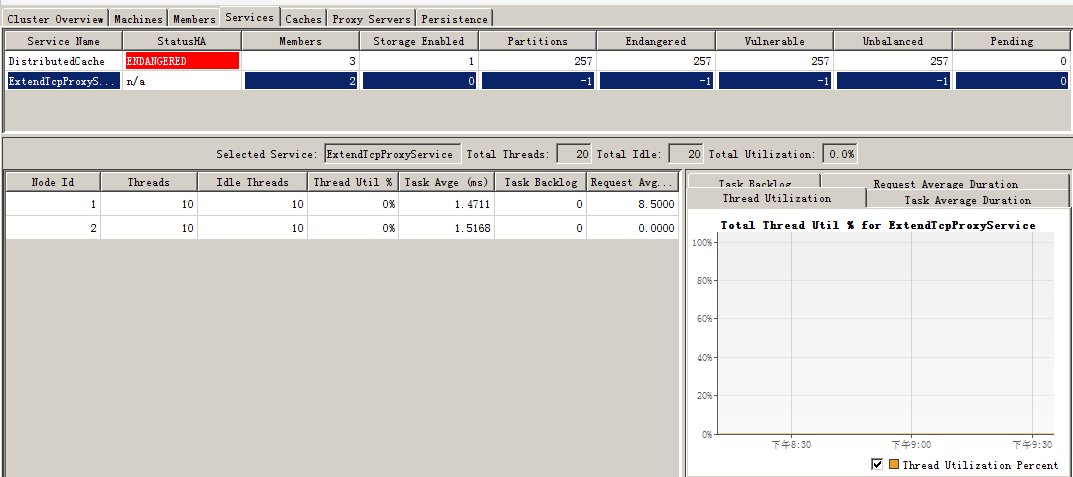
通过jmeter运行20个线程的压力,压力主要压在weblogic server
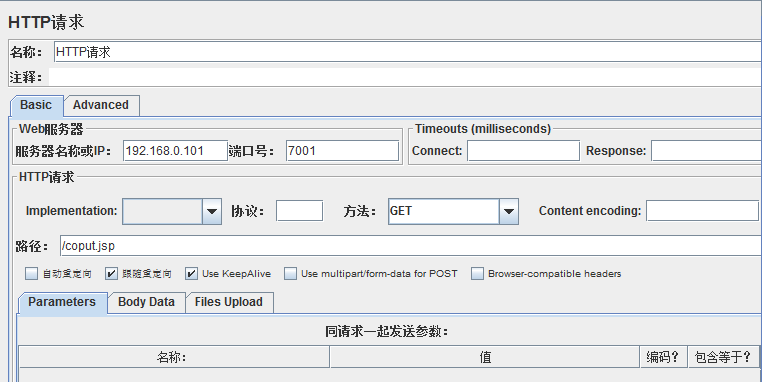
压力上来时候线程如下
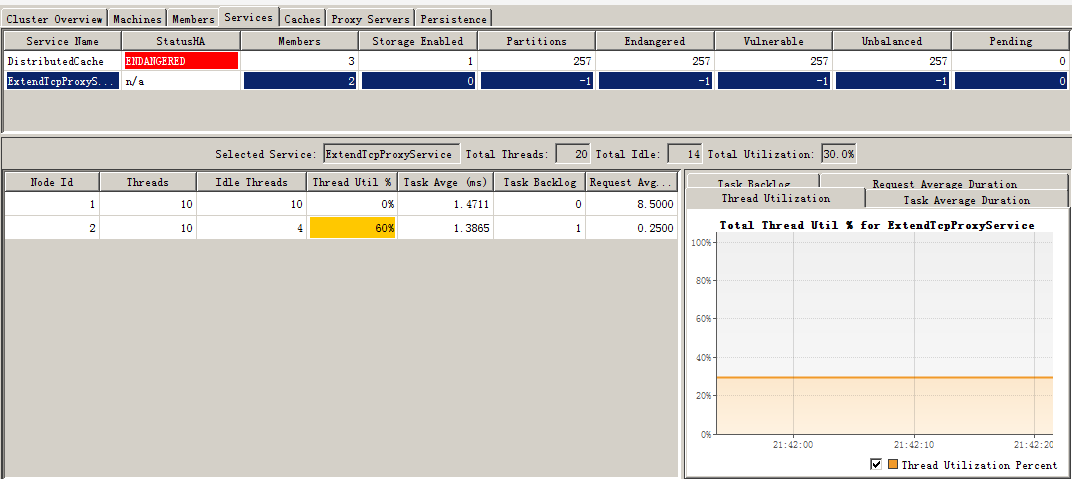
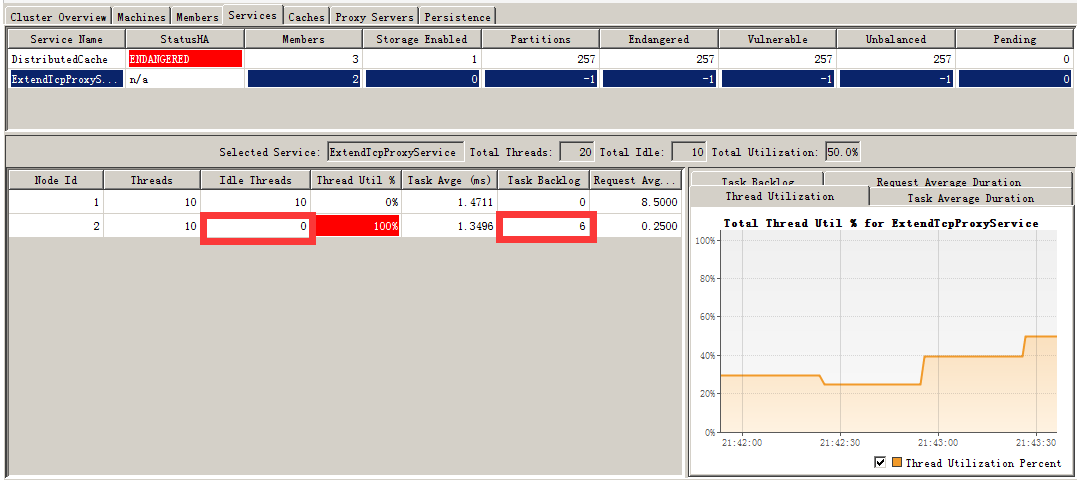
可以看到当空闲线程为0,并且有6个在backlog等待时,都没有分到另外一个proxy.
结论如下:
- Coherence将weblogic server的一个实例当成是一个客户端,并不是基于这个客户端内部的thread进行负载均衡(这不是bug,而是产品设计如此)
- WebLogic Server和Coherence建立的是长连接,除非在超时时间外没有线程访问会断开,在压力比较大的时候,weblogic server会一直用这个连接,并不管这个连接是否已经用完。
- Proxy设置的线程数是有限的,最大512条,proxy占用的资源也是有限的,在压力大的时候可能这个proxy会缓慢甚至挂掉,所以最好的办法还是要把压力分散到不同的proxy上面去。
- 但当多个weblogic实例上来时会进行负载均衡。严格来说,coherence集群是按照client端的NIC和port进行负载均衡的。
修改coput.jsp如下:
也就是会根据不同的thread id,选择加载不同的xml,实现均分。
|
<!DOCTYPE HTML PUBLIC "-//W3C//DTD HTML 4.01 Transitional//EN" <%@ page contentType="text/html;charset=windows-1252"%> <% for (int i=0;i<10000;i++) { %> </body> |
再次进行压力测试,如下:
可以看到压力以及分在两个proxy上.
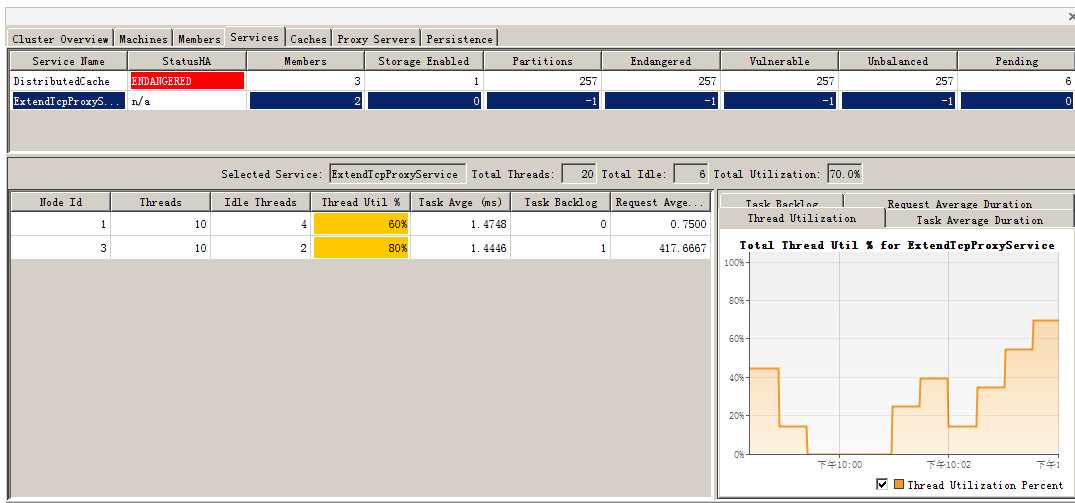
后台weblogic日志,在根据threadid调用.
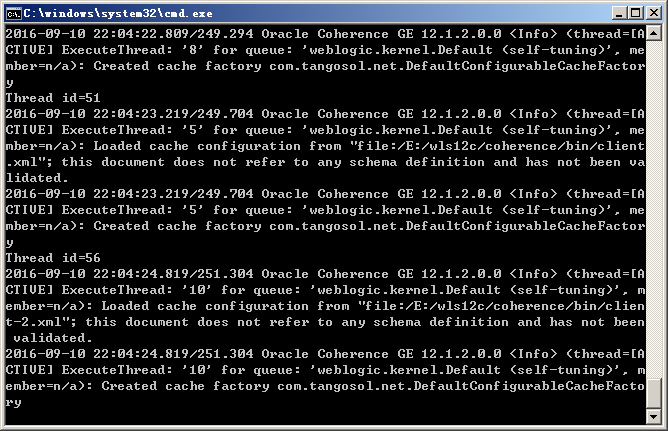
Coherence代理的负载均衡的更多相关文章
- Windos环境用Nginx配置反向代理和负载均衡
Windos环境用Nginx配置反向代理和负载均衡 引言:在前后端分离架构下,难免会遇到跨域问题.目前的解决方案大致有JSONP,反向代理,CORS这三种方式.JSONP兼容性良好,最大的缺点是只支持 ...
- Nginx反向代理,负载均衡,redis session共享,keepalived高可用
相关知识自行搜索,直接上干货... 使用的资源: nginx主服务器一台,nginx备服务器一台,使用keepalived进行宕机切换. tomcat服务器两台,由nginx进行反向代理和负载均衡,此 ...
- Nginx服务器 之反向代理与负载均衡
一.反向代理 正向代理: 客户端要获取的资源就在服务器上,客户端请求的资源路径就是最终响应资源的服务器路径,这就是正向代理.正向代理的特点:就是我们明确知道要访问哪个网站地址. 反向代理: 客户端想获 ...
- Nginx 反向代理、负载均衡、页面缓存、URL重写及读写分离详解
转载:http://freeloda.blog.51cto.com/2033581/1288553 大纲 一.前言 二.环境准备 三.安装与配置Nginx 四.Nginx之反向代理 五.Nginx之负 ...
- Tomcat:利用Apache配置反向代理、负载均衡
本篇主要介绍apache配置反向代理,介绍了两种情况:第一种是,只使用apache配置反向代理:第二种是,apache与应用服务器(tomcat)结合,配置反向代理,同时了配置了负载均衡. 准备工作 ...
- 通过Nginx+tomcat+redis实现反向代理 、负载均衡及session同步
一直对于负载均衡比较陌生,今天尝试着去了解了一下,并做了一个小的实验,对于这个概念有一些认识,在此做一个简单的总结 什么是负载均衡 负载均衡,英文 名称为Load Balance,指由多台服务器以对称 ...
- nginx的反向代理和负载均衡的一个总结
之前一直觉的nginx的反向代理和负载均衡很厉害的样子,最近有机会接触了一下公司的这方面的技术,发现技术就是一张窗户纸呀,捅破了啥都明白了! 接下来先看一下nginx的反向代理: 简单的来说就是ngi ...
- Nginx反向代理、负载均衡、页面缓存、URL重写及读写分离详解
大纲 一.前言 二.环境准备 三.安装与配置Nginx 四.Nginx之反向代理 五.Nginx之负载均衡 六.Nginx之页面缓存 七.Nginx之URL重写 八.Nginx之读写分离 注,操作系统 ...
- nginx和tomcat实现反向代理、负载均衡和session共享
这类的文章很多,nginx和tomcat实现反向代理.负载均衡实现很容易,可以参照http://blog.csdn.net/liuzhigang1237/article/details/8880752 ...
随机推荐
- USACO_1.1_Greedy_Gift_Givers_(模拟+水题)
描述 http://train.usaco.org/usacoprob2?a=y0SKxY0Kc2q&S=gift1 给出不超过$10$个人,每个人拿出一定数量的钱平分给特定的人,求最后每个人 ...
- 网络基础(osi、协议)
*互联网协议 人和人沟通需要一套共同的标准,英语就是普遍的一种,计算机如果需要进行联网互通,也需要一种统一的标准,如果所有的计算机都遵守这种标准,就会实现网络的互联. 1.一系列统一的标准,这些标准称 ...
- tmux下vim颜色不正常问题
在解决了tmux下,make menuconfig颜色不正常问题https://www.cnblogs.com/zqb-all/p/9702582.html后,引入了新的问题,vim颜色错乱. 尝试了 ...
- 一道面试题:C++相比C#或者java的优势到底在哪里
被问到了这样一道面试题,当时就懵了,内心一直觉得C++肯定在很多方面要比C#或者java要牛b的. 但是真的不知道怎么回答. 问题是:你以前一直做得是.NET相关项目,现在为什么找C++开发相关工作呢 ...
- 跟我一起写 Makefile(一)【转】
转自:http://blog.csdn.net/haoel/article/details/2886 跟我一起写 Makefile 陈皓 概述—— 什么是makefile?或许很多Winodws的程序 ...
- Oracle基础 04 归档日志 archivelog
--查看归档模式archive log list select log_mode from v$database; --修改为归档模式(mount下)alter database archivelog ...
- mybatis generator 生成带中文注释的model类
将org.mybatis.generator.interal.DefaultCommentGenerator类的addFieldComment方法重写,代码如下: public void addFie ...
- Ubuntu服务器安装node
查看Ubuntu系统的是32位还是64位 harvey@harvey:/Application$ uname -m #x86_64表示这是64位的系统 x86_64 2. 在nodejs官网ht ...
- 【 Keepalived 】Nginx or Http 主-备模式
一.主-备模式: 操作系统:centos 6.4 x64 ka1: 192.168.2.10 ka2: 192.168.2.11 vip: 192.168.2.200 ka1-master服务器配置 ...
- CSS选择器及其权重
#转载请留言联系 1.标签选择器 标签选择器,此种选择器影响范围大,一般用来做一些通用设置,或用在层级选择器中.举例: div{color:red} ...... <div>这是第一个di ...
